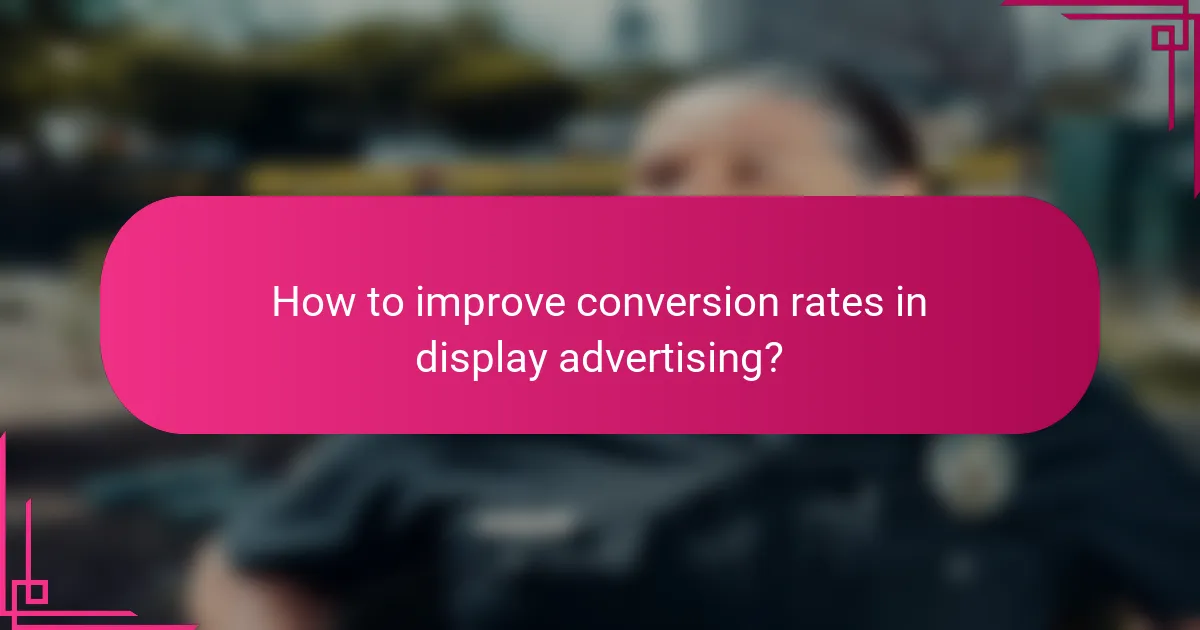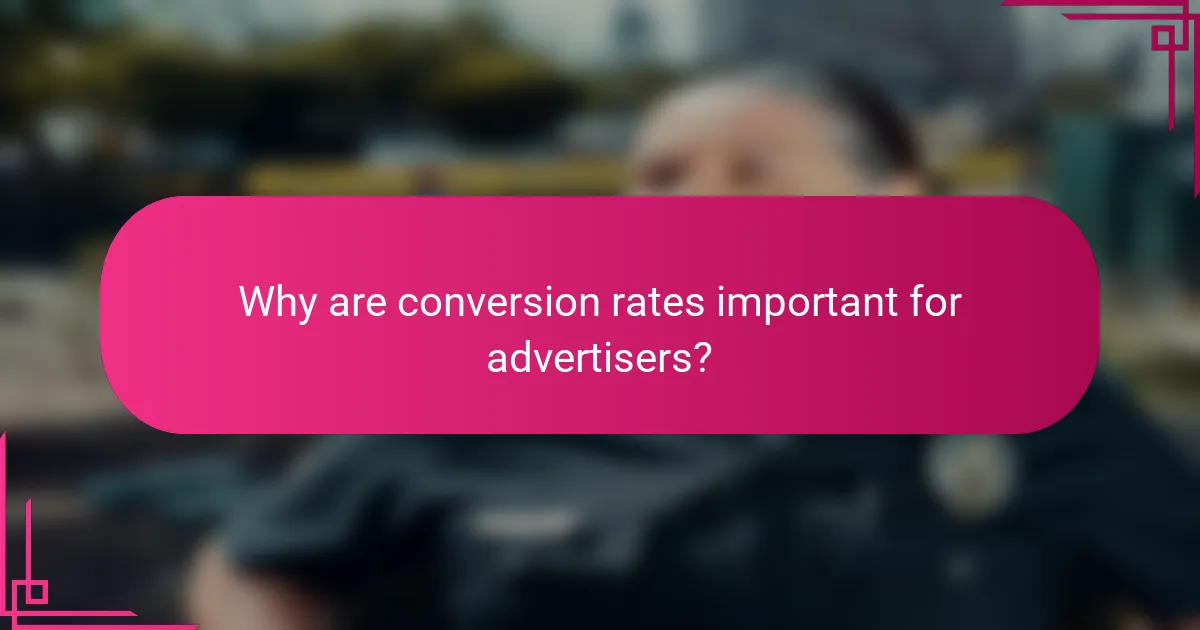Conversion rates are a vital metric that measures the percentage of website visitors who complete a desired action, such as making a purchase or signing up for a newsletter. Understanding and optimizing these rates is essential for evaluating the effectiveness of online marketing strategies and improving user engagement. By focusing on elements like ad creatives and landing page design, businesses can enhance their conversion rates and drive profitability.

How to improve conversion rates in display advertising?
Improving conversion rates in display advertising involves optimizing various elements to encourage user actions. Key strategies include testing ad creatives, refining landing pages, and utilizing data analytics to understand user behavior.
Utilize A/B testing for ad creatives
A/B testing allows advertisers to compare two versions of an ad to determine which performs better. By changing one element at a time, such as the headline or image, you can identify what resonates more with your audience.
Start with a small budget and run tests over a few days to gather sufficient data. Aim for a statistically significant sample size to ensure reliable results. Common pitfalls include testing too many variables at once or not allowing enough time for the test.
Optimize landing page design
The landing page is crucial for converting visitors. Ensure it aligns with the ad’s message and provides a seamless user experience. Key elements include fast loading times, clear navigation, and mobile responsiveness.
Consider using a clean layout with compelling visuals and concise text. A/B test different designs to see which layout leads to higher conversion rates. Avoid clutter and distractions that can divert attention from the call to action.
Implement retargeting strategies
Retargeting involves displaying ads to users who have previously interacted with your website or ads. This strategy helps keep your brand top-of-mind and encourages return visits, which can significantly boost conversion rates.
Use platforms like Google Ads or Facebook Ads to set up retargeting campaigns. Segment your audience based on their interactions to tailor your ads effectively. Be cautious not to overwhelm users with too many ads, which can lead to ad fatigue.
Leverage user behavior analytics
Understanding user behavior through analytics can provide insights into how visitors interact with your ads and landing pages. Tools like Google Analytics can track metrics such as click-through rates and bounce rates.
Analyze this data to identify trends and areas for improvement. Look for patterns in user engagement and adjust your strategies accordingly. Regularly review your analytics to stay updated on user preferences and behaviors.
Enhance call-to-action effectiveness
A strong call to action (CTA) is essential for guiding users toward conversion. Make your CTA clear, compelling, and easy to find. Use action-oriented language that encourages immediate response.
Experiment with different placements, colors, and wording for your CTAs. A/B testing can help determine the most effective variations. Avoid vague phrases and ensure that the CTA aligns with the overall message of your ad and landing page.

What is the definition of conversion rates?
Conversion rates refer to the percentage of visitors to a website who complete a desired action, such as making a purchase or signing up for a newsletter. This metric is crucial for understanding the effectiveness of online marketing efforts and overall user engagement.
Percentage of visitors completing desired actions
The conversion rate is calculated by dividing the number of successful conversions by the total number of visitors, then multiplying by 100 to get a percentage. For example, if a website receives 1,000 visitors and 50 of them make a purchase, the conversion rate would be 5%. Understanding this percentage helps businesses gauge the effectiveness of their sales funnels.
It’s important to consider what constitutes a “desired action” for your specific goals. This could range from purchases and sign-ups to downloads or inquiries. Different industries may experience varying average conversion rates, typically ranging from 1% to 5% for e-commerce sites.
Key metric for measuring advertising effectiveness
Conversion rates serve as a vital indicator of how well advertising campaigns are performing. A high conversion rate suggests that the marketing message resonates with the target audience, while a low rate may indicate the need for adjustments in strategy or messaging. For instance, if a pay-per-click ad campaign has a conversion rate of 2%, it may need optimization to improve engagement.
To enhance advertising effectiveness, businesses should regularly analyze conversion rates alongside other metrics, such as click-through rates (CTR) and return on investment (ROI). This holistic approach can reveal insights into customer behavior and preferences, allowing for more targeted and effective marketing strategies.

Why are conversion rates important for advertisers?
Conversion rates are crucial for advertisers as they measure the effectiveness of marketing efforts in turning potential customers into actual buyers. A higher conversion rate indicates successful engagement and can significantly enhance profitability.
Direct impact on ROI
Conversion rates directly influence return on investment (ROI) by determining how effectively advertising spend translates into revenue. For instance, if an ad campaign costs $1,000 and generates $5,000 in sales, the conversion rate helps assess whether that investment was worthwhile.
Advertisers should aim for a conversion rate that maximizes ROI. Generally, a conversion rate of 2-5% is considered average, while rates above 10% can indicate highly effective campaigns. Regularly analyzing these rates can help adjust strategies to improve financial outcomes.
Indication of audience engagement
Conversion rates serve as a key indicator of audience engagement. A high conversion rate suggests that the target audience finds the content relevant and compelling, while a low rate may signal a disconnect between the message and the audience’s needs.
To enhance engagement, advertisers can test different messaging, visuals, and calls to action. A/B testing can provide insights into what resonates best with the audience, helping to refine approaches and boost conversion rates.
Benchmark for campaign performance
Conversion rates act as a benchmark for evaluating the performance of advertising campaigns. By comparing current rates against historical data or industry standards, advertisers can gauge success and identify areas for improvement.
Setting specific conversion rate goals based on past performance or competitor analysis can guide campaign adjustments. Regular monitoring and reporting on these rates allow for timely interventions, ensuring campaigns remain aligned with business objectives.

What factors influence conversion rates?
Conversion rates are influenced by various factors that can significantly impact user behavior and decision-making. Key elements include ad relevance, landing page performance, and overall user experience, each playing a crucial role in determining how effectively visitors are converted into customers.
Ad relevance and targeting
Ad relevance and targeting are critical for attracting the right audience. When ads are closely aligned with the interests and needs of potential customers, they are more likely to engage and convert. Utilize tools like demographic targeting and keyword optimization to ensure your ads reach the most relevant users.
Consider segmenting your audience based on behavior, location, or preferences. For example, a local bakery might target ads to users within a specific radius, highlighting fresh products and special offers to entice nearby customers.
Landing page load speed
Landing page load speed is vital for maintaining user interest and preventing drop-offs. Research indicates that even a delay of a few seconds can lead to significant decreases in conversion rates. Aim for a load time of under three seconds to keep visitors engaged.
Optimize images, leverage browser caching, and minimize HTTP requests to improve load speed. Tools like Google PageSpeed Insights can help identify areas for enhancement, ensuring a smoother user experience that encourages conversions.
User experience and navigation
User experience and navigation play a pivotal role in guiding visitors toward conversion. A well-structured website with intuitive navigation helps users find what they need quickly, reducing frustration and increasing the likelihood of completing a purchase.
Implement clear calls to action (CTAs) and ensure that important information is easily accessible. For instance, using contrasting colors for buttons and maintaining a logical flow from product selection to checkout can streamline the process and boost conversion rates.

How to analyze conversion rate data?
To analyze conversion rate data effectively, start by identifying key metrics and trends that impact your conversion rates. Use these insights to make informed decisions about your marketing strategies and website optimizations.
Utilize Google Analytics for insights
Google Analytics is a powerful tool for analyzing conversion rate data. It allows you to track user behavior, measure traffic sources, and identify which pages lead to conversions. By setting up goals and funnels, you can see where users drop off in the conversion process.
To get started, ensure that you have goals set up in Google Analytics that align with your business objectives. For example, if your goal is to increase newsletter sign-ups, create a goal that tracks the completion of the sign-up form. Regularly review these metrics to understand trends over time.
Consider segmenting your data to gain deeper insights. For instance, analyze conversion rates by traffic source, device type, or demographic information. This can help you tailor your marketing efforts and optimize user experiences for different audience segments.
